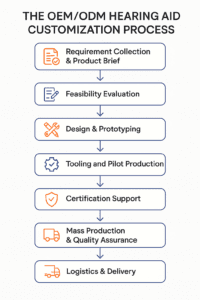In this guide, we break down the entire OEM/ODM hearing aid customization journey—from idea to shipment—so that you, as a procurement professional, can make informed and efficient sourcing decisions.
What Is OEM vs. ODM in Hearing Aids?
OEM: Your Brand, Our Manufacturing
In an OEM model, the hearing aid factory produces products based on your specifications and branding. The product structure exists, but you control its final appearance, packaging, and brand identity.
Examples:
- Branding a pre-designed CIC model with your logo
- Customizing packaging, color, and charging cases
- Selecting pre-approved performance parameters
ODM: From Concept to Finished Product
ODM means the factory develops a brand-new product concept based on your market needs. This option is ideal for large-volume customers looking to stand out in competitive markets.
Examples:
- Designing a rechargeable BTE model with unique app functionality
- Developing a modular hearing aid line with swappable parts
- Customized performance, casing design, and optimized acoustics
Why Choose OEM/ODM for Hearing Aids?
| Benefits | OEM | ODM |
|---|---|---|
| Speed to market | ✅ Fast | ❌ Slower |
| Cost control | ✅ Predictable | ❌ Higher R&D costs |
| Brand flexibility | ✅ Logo & packaging | ✅ Full design control |
| Competitive differentiation | ❌ Limited | ✅ High |
| MOQ requirement | ✅ Lower | ❌ Higher |
| Innovation potential | ❌ Low | ✅ High |
The Hearing Aid OEM/ODM Customization Process
Let’s walk through the steps a professional factory like Goodmi Intelligent follows when customizing hearing aids for clients.
Step 1: Requirement Collection & Product Brief
- Hearing aid type: BTE, ITE, CIC, RIC, Bluetooth
- Target market: age, country, price range
- Branding: logo, packaging, brand story
- Specs: battery type, gain, features, noise control
- Compliance needs: FDA, CE, ISO
Step 2: Feasibility Evaluation
Engineering team checks for feasibility, parts sourcing, MOQ, price, and lead time. A project quote and timeline are provided.
Step 3: Design & Prototyping
- OEM: Branding, color design, samples
- ODM: Product development, firmware tuning, 3D modeling, acoustic testing
Step 4: Tooling and Pilot Production
For ODM, new molds may be required. Small-scale pilot production tests product reliability and packaging validation.
Step 5: Certification Support
- FDA registration (U.S.)
- CE marking under MDR (EU)
- ISO 13485 for QMS compliance
- Labeling and documentation as needed
Step 6: Mass Production & Quality Assurance
- ISO/GMP-compliant production
- Full function testing
- AQL-based quality checks
- Label and user manual inspection
Step 7: Logistics & Delivery
- Shipping terms: EXW, FOB, CIF, DDP
- Air, express, or sea freight
- FBA labeling and documentation support
Common Pitfalls to Avoid
- Overestimating speed for ODM projects
- Skipping compliance planning
- Choosing factories without ISO or CE/FDA credentials
- Lack of clear communication or follow-up

Why Choose Goodmi Intelligent?
With over 14 years of experience, Goodmi Intelligent (Shenzhen) Co., Ltd. offers:
- ISO 13485 certified facility
- FDA & CE registered hearing aids
- Over 100,000 units/month production capacity
- Rapid prototyping and packaging customization
- Professional OEM/ODM support with NDA protection
Start Small, Scale Smart
Whether launching a private label or building a fully customized hearing aid, the OEM/ODM process provides flexible options for various budgets and timelines. Work with certified, experienced manufacturers to minimize risks and accelerate time to market.
📩 Ready to customize your hearing aid brand?
Contact our OEM/ODM team today to get started.




